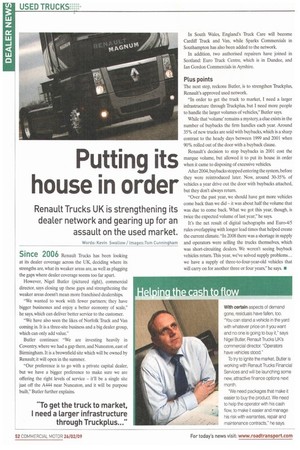Putting its house in order
Page 52

If you've noticed an error in this article please click here to report it so we can fix it.
Renault Trucks UK is strengthening its dealer network and gearing up for an assault on the used market.
Words: Kevin Swallow / Images7Tom Cunningham Since 2006 Renault Trucks has been looking at its dealer coverage across the UK, deciding where its strengths are, what its weaker areas are, as well as plugging the gaps where dealer coverage seems too far apart.
However, Nigel Butler (pictured right), commercial director, says closing up these gaps and strengthening the weaker areas doesn't mean more franchised dealerships.
"We wanted to work with fewer partners; they have bigger businesses and enjoy a better economy of scale," he says, which can deliver better service to the customer.
"We have also seen the likes of Norfolk Truck and Van coming in. It is a three-site business and a big dealer group, which can only add value."
Butler continues: "We are investing heavily in Coventry, where we had a gap there, and Nuneaton, east of Birmingham. It is a brownfield site which will be owned by Renault; it will open in the summer.
"Our preference is to go with a private capital dealer, but we have a bigger preference to make sure we are offering the right levels of service — it'll be a single site just off the A444 near Nuneaton, and it will be purpose built," Butler further explains. In South Wales, England's Truck Care will become Cardiff Truck and Van, while Sparks Commercials in Southampton has also been added to the network.
In addition, two authorised repairers have joined in Scotland: Euro Truck Centre, which is in Dundee, and Ian Gordon Commercials in Ayrshire.
Plus points
The next step, reckons Butler, is to strengthen Truckplus, Renault's approved used network.
"In order to get the truck to market, I need a larger infrastructure through Truckplus, but I need more people to handle the larger volumes of vehicles," Butler says.
While that 'volume' remains a mystery a clue exists in the number of buybacks the firm handles each year. Around 35% of new trucks are sold with buybacks, which is a sharp contrast to the heady days between 1999 and 2001 when 90% rolled out of the door with a buyback clause.
Renault's decision to stop buybacks in 2001 cost the marque volume, but allowed it to put its house. in order when it came to disposing of excessive vehicles.
After 2004, buybacks stopped entering the system, before they were reintroduced later. Now, around 30-35% of vehicles a year drive out the door with buybacks attached, but they don't always return.
"Over the past year, we should have got more vehicles come back than we did — it was about half the volume that was due to come back. What we got this year, though, is twice the expected volume of last year," he says.
It's the net result of digital tachographs and Euro-4/5 rules overlapping with longer lead times that helped create the current climate. "In 21108 there was a shortage in supply and operators were selling the trucks themselves, which was short-circuiting dealers. We weren't seeing buyback vehicles return. This year, we've solved supply problems... we have a supply of three-to-four-year-old vehicles that will carry on for another three or four years," he says. •
















































































































































